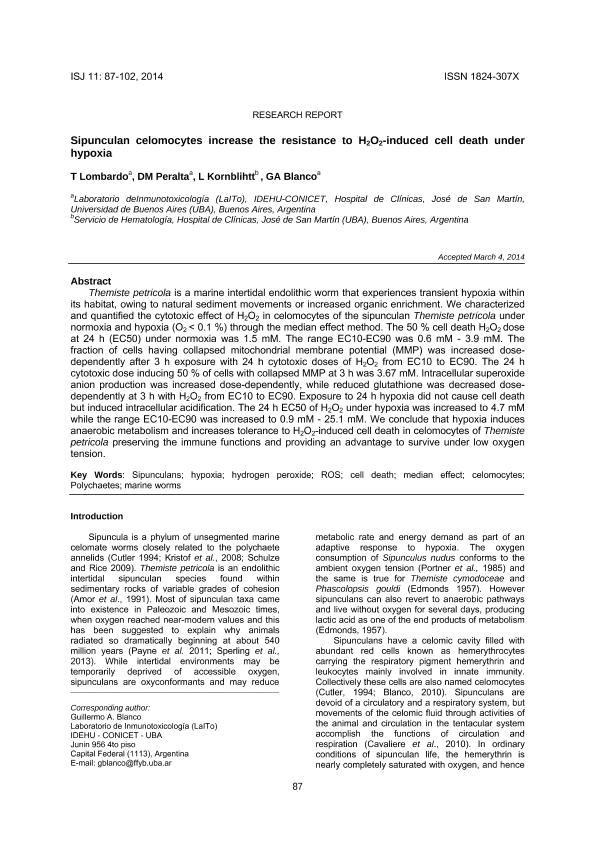Mostrar el registro sencillo del ítem
dc.contributor.author
Lombardo, Tomás

dc.contributor.author
Peralta, Diego Matias

dc.contributor.author
Kornblihtt, L.
dc.contributor.author
Blanco, Guillermo Armando C.

dc.date.available
2016-11-07T20:51:34Z
dc.date.issued
2014-04
dc.identifier.citation
Lombardo, Tomás; Peralta, Diego Matias; Kornblihtt, L.; Blanco, Guillermo Armando C.; Sipunculan celomocytes increase the resistance to H2O2-induced cell death under hypoxia; Universidad de Modena; Invertebrate Survival Journal; 11; 4-2014; 87-102
dc.identifier.issn
1824-307X
dc.identifier.uri
http://hdl.handle.net/11336/8042
dc.description.abstract
Themiste petricola is a marine intertidal endolithic worm that experiences transient hypoxia within its habitat, owing to natural sediment movements or increased organic enrichment. We characterized and quantified the cytotoxic effect of H2O2 in celomocytes of the sipunculan Themiste petricola under normoxia and hypoxia (O2 < 0.1 %) through the median effect method. The 50 % cell death H2O2 dose at 24 h (EC50) under normoxia was 1.5 mM. The range EC10-EC90 was 0.6 mM - 3.9 mM. The fraction of cells having collapsed mitochondrial membrane potential (MMP) was increased dose-dependently after 3 h exposure with 24 h cytotoxic doses of H2O2 from EC10 to EC90. The 24 h cytotoxic dose inducing 50 % of cells with collapsed MMP at 3 h was 3.67 mM. Intracellular superoxide anion production was increased dose-dependently, while reduced glutathione was decreased dose-dependently at 3 h with H2O2 from EC10 to EC90. Exposure to 24 h hypoxia did not cause cell death but induced intracellular acidification. The 24 h EC50 of H2O2 under hypoxia was increased to 4.7 mM while the range EC10-EC90 was increased to 0.9 mM - 25.1 mM. We conclude that hypoxia induces anaerobic metabolism and increases tolerance to H2O2-induced cell death in celomocytes of Themiste petricola preserving the immune functions and providing an advantage to survive under low oxygen tension.
dc.format
application/pdf
dc.language.iso
eng
dc.publisher
Universidad de Modena
dc.rights
info:eu-repo/semantics/openAccess
dc.rights.uri
https://creativecommons.org/licenses/by-nc-sa/2.5/ar/
dc.subject
Sipuncula
dc.subject
Hypoxia
dc.subject
Hydrogen Peroxide
dc.subject
Ros
dc.subject.classification
Otros Tópicos Biológicos

dc.subject.classification
Ciencias Biológicas

dc.subject.classification
CIENCIAS NATURALES Y EXACTAS

dc.title
Sipunculan celomocytes increase the resistance to H2O2-induced cell death under hypoxia
dc.type
info:eu-repo/semantics/article
dc.type
info:ar-repo/semantics/artículo
dc.type
info:eu-repo/semantics/publishedVersion
dc.date.updated
2016-11-07T15:41:16Z
dc.journal.volume
11
dc.journal.pagination
87-102
dc.journal.pais
Italia

dc.journal.ciudad
Amsterdam
dc.description.fil
Fil: Lombardo, Tomás. Consejo Nacional de Investigaciones Cientiâficas y Tecnicas. Oficina de Coordinacion Administrativa Houssay. Instituto de Estudios de la Inmunidad Humoral "profesor R. A. Margni"; Argentina
dc.description.fil
Fil: Peralta, Diego Matias. Consejo Nacional de Investigaciones Cientiâficas y Tecnicas. Oficina de Coordinacion Administrativa Houssay. Instituto de Estudios de la Inmunidad Humoral "profesor R. A. Margni"; Argentina
dc.description.fil
Fil: Kornblihtt, L.. Universidad de Buenos Aires. Facultad de Medicina. Hospital de Clínicas General San Martín; Argentina
dc.description.fil
Fil: Blanco, Guillermo Armando C.. Consejo Nacional de Investigaciones Cientiâficas y Tecnicas. Oficina de Coordinacion Administrativa Houssay. Instituto de Estudios de la Inmunidad Humoral "profesor R. A. Margni"; Argentina
dc.journal.title
Invertebrate Survival Journal
dc.relation.alternativeid
info:eu-repo/semantics/altIdentifier/url/http://www.isj.unimo.it/articoli/ISJ318.pdf
Archivos asociados
